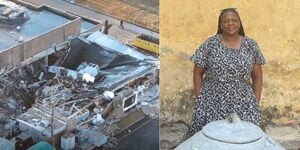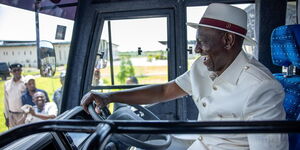In the case of most passengers, a flight experience entails navigating through the airport, security checks, boarding the plane and ultimately culminates with the exquisite view during the flight.
However, not all features of a plane stand out to everyone. Be it a hidden handrail or a hole on the windows, there are some features that the passengers may have never noticed.
Kenyans.co.ke takes a look at five little-known features about airplanes and their crucial roles.
A black triangle above the plane's window
Once passengers get on the airplane, it's possible that they would miss this security feature.
Located above the windows, the triangle usually lines up with the edge of the airplane's wing. Throughout the triangle, a flight attendant gets the clearest view of the wing and is able to assess its airworthiness.
Reports indicate that passengers who get motion sick during the travel are usually advised to move to seats located between the triangle as it would give a passenger the smoothest ride since the wings are the plane's center of gravity.
Holes in the windows
A closer look at the window would reveal a hole in the bottom. The hole helps to balance the pressure difference between the inside and outside of the plane.
Primarily known as a breather hole, it's used to balance the amount of pressure that passes between the window's inner and outer panes.
The hole serves as a safety feature whereby the outer pane bears the most pressure and if it gives out, passengers would still breathe.
Further, the hole keeps the windows from accumulating fog or mist by absorbing the moisture that gets stuck between the panes. This allows a clear view of the windows at high altitudes.
Secret sleeping area
Ever wondered where the cabin crew go to rest or sleep during flights?
Aircrafts are designed with compartments for flight attendants and the cabin crew to rest or take break, especially during long hour flights.
There are secret passageways to the sleeping area which is behind a locked door. The door is located near the front of the plane and is kept anonymous with thick curtains.
Hooks on the wings
This is another safety feature used when an airplane has to make an emergency landing on water.
In order to aid the passengers to get off the plane without failing, the cabin crew attaches the ropes to one hook and fastens it to the other hook.
Pilots in past reports affirm that the hook is essential as it gives the passengers a safer stand on the slippery surface when they are on top of the wing.
Handrail
Unbeknown to many, there is a handrail feature located below the overhead bins.
The feature is aimed at helping passengers traverse the plane with ease and without having to grab the headrest of each seat for support.
Reports indicate that the feature has been built in most airplanes in the past 15 years, however, most passengers move through the cabin difficulty while holding on to every seat.












